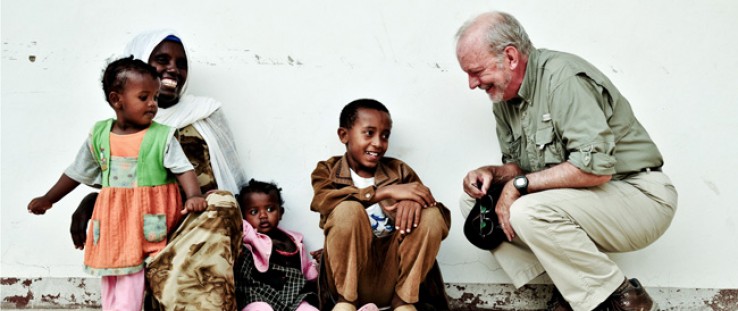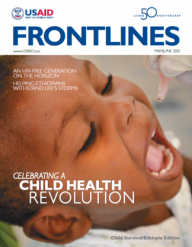 Anthony Lake converses with a family outside a health center in Ethiopia in June 2009, before taking up his post with UNICEF, as part of a trip with ONE.
ONE/ Morgana Wingard
Anthony Lake converses with a family outside a health center in Ethiopia in June 2009, before taking up his post with UNICEF, as part of a trip with ONE.
ONE/ Morgana Wingard
 Anthony Lake converses with a family outside a health center in Ethiopia in June 2009, before taking up his post with UNICEF, as part of a trip with ONE.
ONE/ Morgana Wingard
Anthony Lake converses with a family outside a health center in Ethiopia in June 2009, before taking up his post with UNICEF, as part of a trip with ONE.
ONE/ Morgana Wingard
FRONTLINES: What have been UNICEF’s greatest achievements in child survival?
ANTHONY LAKE: There has been tremendous progress in child survival: The child mortality rate has dropped by 35 percent since 1990. That statistic represents around 4.3 million fewer children under the age of 5 dying from preventable causes. No single organization can claim credit for that achievement, and we still have a long way to go. But I am proud of UNICEF’s role. In addition to our staff—whose work on the ground in more than 150 countries and territories has made an enormous difference—I believe UNICEF’s most important contribution has been innovation. Technical innovation, of course, but also innovation in how we think about development.
That was the genius behind the child survival revolution in the 1980s, which my friend Jim Grant helped lead when he was UNICEF executive director. Jim encouraged us to see child survival not only as a measure of a country’s development progress, but also as a means of achieving that progress. He pushed us to extend the reach of our interventions for children with cost-effective solutions to huge problems. Some of the high-impact, low-cost innovations UNICEF helped pioneer then included: oral rehydration salts, greatly expanded vaccination campaigns, and developing supply chains to reach the most remote communities.
UNICEF continues to work at innovating. Sometimes that means repurposing existing technology to help us reach the hardest-to-reach places. Just look at what is being done with SMS texting and other mobile technology. We are using this now in the field to record and transmit data that helps us track the spread of diseases. It’s helping us expedite HIV test results and start treatment that can prevent the transmission of HIV from mother to child and extend mothers’ lives. It’s enabling us to record births in remote places, and to reunify families during conflicts and natural disasters. It even helps us to monitor the outcome of our own programs, for instance, tracking the delivery of school materials. Some of our more innovative work has been recognized—Devex recently named UNICEF a Top Development Innovator, based on a poll of thousands of development professionals. We’re encouraged by the recognition, but we also have to work to earn it, working collaboratively with our partners.
I say collaboratively because, if innovation is key to the new child survival revolution, partnership is certainly the key to innovation. Partnerships with cell phone manufacturers, software programmers, telecom companies; partnerships with other agencies like USAID; above all, partnerships with governments. For only they can take these innovations to scale.
FRONTLINES: UNICEF is working with USAID and other global actors to focus and sharpen strategies to reach the end of preventable child deaths. What has to happen to make this lofty goal a concrete reality?
LAKE: Equity. We may never literally end all preventable child deaths, but we can come close. To do so, as a practical matter, we have to help nations with the highest infant mortality rates vastly reduce them, with a much sharper focus on reaching the most disadvantaged children. It is also, in any case, the right thing to do; and it is also cost-effective. Traditional development thinking has held that attempts to reach the very poorest, especially in remote areas, are too costly and too difficult. But new technology and innovations such as those I just mentioned are making it easier to reach the most deprived. So in 2010, UNICEF tested the traditional thinking in an extensive modeling exercise. Our study shows that, in fact, the additional results that you achieve in those communities outweigh the additional costs of getting into them. Indeed, our modeling shows that in the poorest countries with the highest child mortality rates, for every additional $1 million invested, an equity strategy averts up to 60 percent more children’s deaths.
These findings are especially significant now, in a time of continued fiscal austerity. Focusing on the most disadvantaged is right in principle and right in practice. Now we need to do a better job analyzing the data—looking beyond national averages that often conceal children in greatest need. According to our analysis, within a majority of the countries on track to meet Millennium Development Goal 4—reducing child mortality—gaps between rich and poor children are actually widening. That’s simply wrong.
FRONTLINES: What do you count as the simplest interventions that can make the biggest difference on closing the gap between developing and developed countries on child survival?
LAKE: Let me start by saying that the old distinctions between “developing” and “developed” nations are eroding. The majority of the world’s poor now live in middle-income countries. Many industrialized nations face difficult challenges, too. And some of the lowest-income countries are among the most innovative. So we need to consider more universal goals, and focus on finding the most effective—and the most cost-effective—ways to reach the children in greatest need.
Very often, these are also the simplest ways. Consider micronutrients, such as vitamin A, iodized salt, iron and zinc. These are inexpensive, easy to deliver interventions. And yet, they have the power to help prevent stunting in millions of children. Stunting is a condition caused by a lack of essential nutrients during the critical period of pregnancy and up to the age of 2. Children who are stunted suffer from irreversible physical and cognitive harm, with tragic consequences for those children and for their societies. In 2008, the Copenhagen Consensus—a group of leading economists, including Nobel Prize winners—concluded that the provision of micronutrients was the single most cost-effective means of improving global welfare.
Vaccination is another highly cost-effective intervention. It provides an enormous return on investment, regardless of how it is measured, whether in terms of deaths averted, fewer illnesses or lower health costs. Too little attention has been paid to the critical importance of vaccination since we achieved so-called “universal vaccination” in 1990. At the time, “universal” meant around 80 percent. But we declared victory too early. We are still only at around 85 percent globally, and we have to accelerate the pace if we’re going to achieve our child survival goals. Never forget that diseases that were nearly defeated—such as polio—can come back if we don’t finish the job.
FRONTLINES: What are three issues poor children face today that most people would be surprised to know?
LAKE: The first is the issue I just mentioned: stunting, which truly is one of the most under-recognized and under-addressed issues children face. One hundred eighty million children are already afflicted by this condition. If they were all concentrated in one place, it would constitute a massive emergency and compel immediate action. Stunting occurs even in food-secure nations such as India, where 48 percent of the children under the age of 5 are stunted. In some places, stunting is so common that it is actually mistaken for genetic heritage. And yet, very few people—even development and medical professionals—have even heard of it. This is beginning to change, but we have a long way to go.
The second surprising issue is urban disparities. The world is rapidly becoming urbanized. Within a few years, half of the world’s children will live in cities and towns. While many people still think of a rural child when they think of a poor child, children in the poorest urban communities are often just as deprived—of nutrition, clean water, adequate sanitation, access to health care, education and protection. But their situations are often masked by data showing that urban children are generally better off. So we need to do a much better job of analyzing data and mapping urban areas—both within and beyond slums—to find out who and where the most disadvantaged children are. This information will help governments and all of us better target our efforts and better achieve results.
There are certainly more than three issues people would be surprised to know. But the third one I’ll mention also surprised me when I first came to UNICEF: the lack of birth registration, especially among the most disadvantaged and marginalized children, such as those from indigenous groups, children with disabilities, and, of course, girls as compared with boys. Only half of all children under 5 are registered in developing countries. Why is this important? Lack of birth registration can cause a lifetime of exclusion and deprivation, making it harder for children who are already at risk of being left behind to go to school, or to get medical treatment, or to be reunited with their parents in emergencies. And again, a cost-effective intervention—the simple act of registering a birth, made more simple now by things like mobile technology—can yield lifelong benefits.
FRONTLINES: Is there a real role for technology, such as simple laptops, to help poor children catch up with their peers in the developed world? What are the challenges to and costs of making this work effectively?
LAKE: Technology is already playing an enormous role in development and, increasingly, in our ability to reach the poorest children. And as I mentioned earlier, it goes well beyond laptops—SMS texting and other mobile communications are connecting children and communities to a world of information and increasing their access to critical services. And in Uganda, not everyone has a cell phone, of course, but there are telephone booths all over the country—so we are developing a program to adapt mobile apps for telephone booths.
The first challenge is to re-purpose technology that the private sector is developing and apply it to our own purposes. The second challenge is to take these innovations to scale. This is one of UNICEF’s highest priorities—and, as with all of our goals, it depends on partnership.
The majority of the most promising innovations have come about through partnerships—collaboration with the private sector, governments, academia and, most importantly, communities themselves. For example, the Digital Drum—a solar-powered computer kiosk for rural children and communities in Uganda—was mostly developed in a collaboration, often virtual, that linked UNICEF staff, technologists, academics and designers from Solomon Islands, South Africa, Suriname, Uganda and the United States of America. Its development, in fact, may have been one of its greatest innovations, for the process inspired a great deal of thinking about access to information in rural contexts.
Time magazine named the Digital Drum as one of the best inventions of 2011—and UNICEF is proud of that. But regardless of who creates an innovative new use of technology, the point is to share it, to build on it, and to extend its reach. Because the sooner we can roll these innovations out in cooperation with others, the more children’s lives we can improve and save.
FRONTLINES: During your travels as head of UNICEF, has a child said something that you’ll never forget, the proverbial “out of the mouths of babes” statement that sticks with you?
LAKE: More than their words, I think of their laughter. I’ve met children in horrible circumstances: in drought-ravaged areas in Africa … in monsoon-flooded parts of Pakistan … in earthquake-flattened communities in Haiti or Japan. In places where there is almost nothing, children always find a way to laugh and play … with balls and dolls they make from rags and bits of things they find, wherever they are. They are incredibly resourceful. And the more I meet these children and their families, the more I understand that they are not simply victims in need of our pity. They are courageous, hard-working survivors, in need of—and deserving of—our support. An inspiration.










Comment
Make a general inquiry or suggest an improvement.